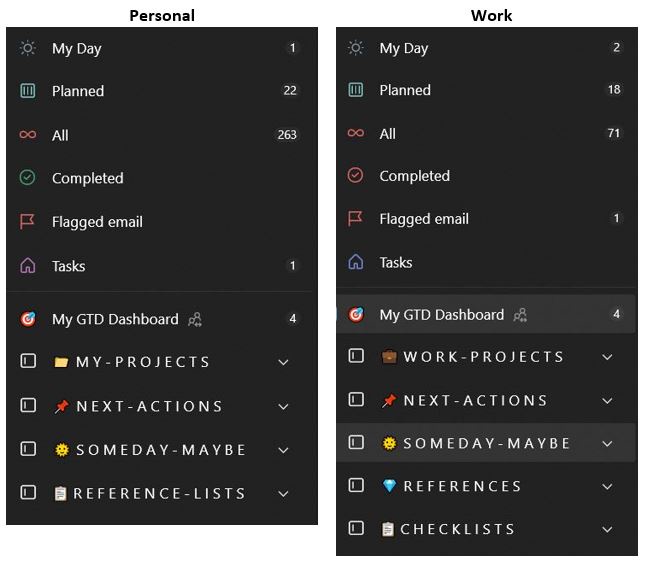GTD Journey: Getting back to Nirvana (August 2023 edition)
For the surprise of absolutely no one, I'm back with the Nirvana app for my tasks and projects. 😏

I lasted roughly 2 months with my 2-accounts setup in Microsoft To Do. All the integration features offered by MS To Do that I thought were detrimental to my daily setup ended up not being that important.
Drawbacks of Microsoft To Do
Over the past two months, I've found myself utilizing the file attachment feature only once.
Although the option to flag emails in Outlook and synchronize them with Microsoft To Do seemed promising, it didn't significantly impact my workflow.
The handling of recurring tasks also posed a challenge – the lack of separate copies meant that altering the due date by a day affected the entire task series.
While Microsoft To Do serves me well during less hectic periods, I've noticed a pattern: when faced with complex projects at work, I tend to feel overwhelmed. This is where I remember the effectiveness of the Nirvana app to deal with it all. Nirvana just makes more sense with how I compartmentalize multiple projects and next actions.
This brings to mind the classic GTD (Getting Things Done) discussion about linking projects to next actions.
The truth is: there is no right or wrong way to do it.
The fundamental principle is: maintain a a list of current projects to review weekly and assign one next action to each project to move them forward. That's it. But for some people (like me) it is beneficial to group next actions by project. Occasionally, the project itself defines my entire focus for the day.
Microsoft To Do attempted to facilitate this organizational aspect with hashtags, but it felt somewhat loosely structured for my taste. Without a centralized list of hashtags, I found myself typing various versions of the same hashtag for a single project, leading to confusion.
Also, the pop-up hashtag list that appears when adding a new task doesn't work when editing a task post-insertion, requiring me to recall the correct hashtag or go search for it.
The 2-accounts setup also was a bit cumbersome, because in my head I didn't have one unified Inbox. I prefer having no friction at all for capturing things. Capturing tasks should be effortless and instinctive, without any unnecessary cognitive load. However, I often found myself contemplating whether a task belonged to my work or personal account, disrupting the capture momentum.
It took time and experimentation to determine what truly suits me. Through trial and error – as you can see documented in my GTD Journey blog posts – I've gained clarity (finally!). Microsoft To Do is undeniably a great simple app, yet Nirvana resonates more closely with the natural functioning of my mind.
All that being said...
The little things that make me come back to Nirvana:
- Nirvana guides me towards a more disciplined GTD approach by neatly categorizing everything into predefined sections. This alignment with GTD principles removes the need to invest excessive time in personalizing settings (a big win, especially for someone like me who can get lost in endless customization choices!).
- Nirvana handles recurring tasks better than many tools, since it doesn't bother me with them until the start date. This clever approach involves creating new instances of tasks for their upcoming occurrences. I can even adjust individual due dates without disrupting the original sequence. Also, I appreciate the option to set deadlines and determine how many days in advance tasks appear in the “Focus” section (I use that a lot!).
- The way Nirvana integrates next-actions with projects is amazing.
- It has Start Dates (very hard to see in other apps).
- I love how Scheduling works by keeping a next action hidden until they are ready to appear in the “Focus” section.
After years of back and forth I've come to this conclusion: Nirvana aligns closely with my personal work style and preferences, making it my preferred choice over Microsoft To Do or any other task managers.
At the end of the day it's all about trusting the system and regularly reviewing my lists (weekly reviews!). Consistency is key – the more consistently I engage with my system, the more reliable it becomes, reinforcing my confidence in it.
I feel that I completely trust Nirvana right now👍.
So, I’ll renew my promise: I will stick with it for at least a year and re-evaluate.
#GTD #productivity #MSTodo #Nirvana #apps
Thoughts? Discuss... if you have a Write.as account or Reply by email
By Noisy Deadlines Minimalist in progress, nerdy, introvert, skeptic. I don't leave without my e-reader.


 * N E X T A C T I O N S📌: each list is a different context, classic GTD
* N E X T A C T I O N S📌: each list is a different context, classic GTD








